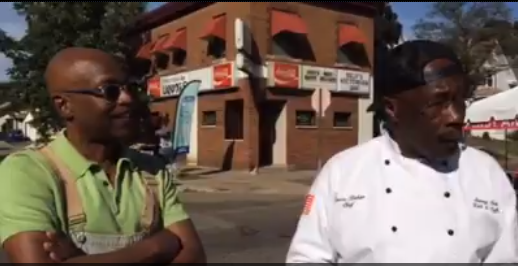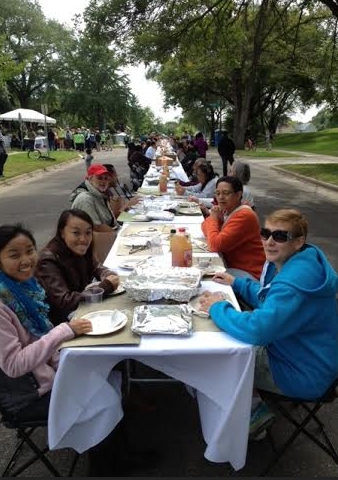They began arriving hours in advance. Over 400 volunteers--farmers, cooks, drivers, mobile art kitchens, dance choreographers, spoken word poets, food servers, food runners, zero waste managers, and table hosts. And when the bell rang, nearly 2,000 guests followed the signs in Somali, Spanish, Hmong, and English and took their seats on Sunday, September 14--at a half-mile long dinner table along Victoria Street in St. Paul, Minnesota--to take part in the performance.
Welcome to CREATE: The Community Meal, the ambitious and jubilant public art event by nationally acclaimed artist Seitu Jones that has placed the urban Frogtown neighborhood and Public Art St. Paul in the forefront of the nation's growing conversation over food justice, and access to healthy food and farms.
"We all have a food story," Jones said, standing by the lineup of tables, only a half block from his storefront studio in the neighborhood. "Our next food story needs to be written to create a fair and just food system, a story that equitably shares the benefits and risks of where, what and how food is grown, processed, transported, distributed, accessed and eaten."
Seitu Jones and Chef James Baker, photo courtesy of Kate Maxwell Williams
How do you turn a "food swamp" into an urban farm and food catalyst for the city?
After years of watching his Frogtown neighbors pass his storefront studio with bags of processed foods from a limited convenience store, Jones and AfroEco, a group of African American environmentalists, undertook a food assessment that identified obstacles for healthy food choices in the area beyond high costs: Namely, the lack of access, and the loss of food traditions and cooking habits.
Check out Jones' interview with Janis Lane-Ewart on KFAI's Collective Eye on the event's background.
Working with local farmers, cooks and artists, Jones and Public Art St. Paul fashioned CREATE into a zero waste public art initiative to take the challenge of bringing healthy food directly to the table. Canvassing the Frogtown neighborhood several times, collecting stories over a year, he invited his neighbors to a special dinner for two--thousand.
"To give everyone a place at the table," St. Paul volunteer Ellen Muller said, setting out hand-made place mats produced from bio-waste and burdock plants by artist Mary Hark. Muller added, "Especially in a neighborhood that has been on the raw end of development," citing historical displacement from the 1-94 highway, among other issues.
For St. Paul resident Kathy Schoenberg-Ebertz, volunteering as a food server was a unique opportunity to be part of the performance and join the Frogtown community.
Led by chef James Baker, with a menu drawn from a collection of neighborhood food stories among African-American, Hmong, Somali, Latino and European American residents, hosts served a locally-produced meal of ginger-honey soy chicken, Ethiopian fosolia green beans, collard greens, black beans and rice, corn bread and a mixed salad, along with apple cider.
"In this way," said St. Paul volunteer Peyton Ginakes, a Ph.D student at the University of Minnesota in Sustainable Agriculture, "we all become part of the harvest."
"Those black beans, about 400 pounds, were farmed and harvested by Porfirio Perez and his family," Big River Farm manager Aaron Blyth told me, sitting across the table. Working with immigrant farmers from 10 different countries, Big River Farms has provided a certified organic vegetable component to the meal, along with land, resources and training for diverse farmers. Like the work of Perez, a Guatemalan immigrant, Blyth described how three farmers from different backgrounds and languages, as Kenyans, Hmong and African Americans, worked together to provide the fresh salad.
Pointing over his shoulder at the future site of the Frogtown urban farm, a long-time community initiative to obtain land for a park and farm, Blyth discussed how immigrants brought innovative new markets to the area.
Photo by Jeff Biggers
While the event called to mind Dante's concept of the "convivio"--the great banquet of food stories--Jones invoked Martin Luther King, Jr.'s idea of the "beloved community," adding food justice to the twin pillars of economic and social justice. The meal, in fact, began with a poem of grace, written by GE Patterson, and a closing by Soyini Guyton, as hosts served the main entree in a dance movement choreographed by artist Ananya Chatterjea.
"This reminds me how rushed we've gotten in our meals," Diane Natrop said, sitting at the head of one end of the table, "and so far away from the joy of cooking." Natrop, who lived only two doors away from the Victoria Street event, sat next to her two daughters and Minneapolis resident Leann Johnson, a self-described "recovering farm kid." They exchanged stories about their family food traditions, the problems of access today, and the joy of rediscovering an apple butter recipe. "It's time to get back to cooking," Natrop told her daughters.
It was clear their conversation, like those among two thousand others, would last far beyond this one meal. Plans for the follow-up legacy dinner, as Jones hoped, had just begun.


